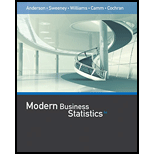
A survey asked the following question: Do you favor or oppose providing tax-funded vouchers or tax deductions to parents who send their children to private schools? Of the 2010 individuals surveyed, 905 favored the proposal, 1045 opposed the proposal, and 60 offered no opinion. Do the data indicate a significant difference in the preferences for the financial support of parents who send their children to private schools? Use a .05 level of significance.
Check whether there is significant difference in the preferences for the financial support of parents who send their children to private schools or not.
Answer to Problem 38SE
There is significant difference in the preferences for the financial support of parents who send their children to private schools.
Explanation of Solution
Calculation:
There are total of 2010 individuals, of which 905 favored the proposal, 1,045 opposed the proposal and 60 offered no opinion. The level of significance is 0.05.
The proportion of who favour the proposal is denoted as p.
The hypotheses are given below:
Null hypothesis:
That is, there is no difference in the preferences for the financial support of parents who send their children to private schools.
Alternative hypothesis:
That is, there is a difference in the preferences for the financial support of parents who send their children to private schools.
From the data, there are
For a sign test, the mean is
The mean is,
Thus, the mean is 975.
The standard deviation is,
Thus, the standard deviation is 22.0794.
The probability of 905 plus signs in the lower tail can be obtained by using the continuity correction factor and normal approximation. Hence, the p-value is obtained by using normal distribution with
Procedure:
Step by step procedure to obtain the above probability using Table 1 of Appendix B is given below:
- Locate the value –3.1 in the column, named z.
- Move towards the right along the row of –3.1, till the column named 0.05 is reached.
- The cell at the intersection of the row –3.1 and the column 0.05 gives the cumulative probability corresponding to the standard normal variable value -3.15.
Thus,
That is,
The two tailed p-value is,
Rejection rule:
If
Conclusion:
Here the level of significance
Here,
That is, p-value is less than significance level.
Therefore, the null hypothesis is rejected.
Thus, there is evidence to support the claim that “there is significant difference in the preferences for the financial support of parents who send their children to private schools”.
Want to see more full solutions like this?
Chapter 18 Solutions
Modern Business Statistics with Microsoft Office Excel (with XLSTAT Education Edition Printed Access Card) (MindTap Course List)
- Let X be a random variable with support SX = {−3, 0.5, 3, −2.5, 3.5}. Part ofits probability mass function (PMF) is given bypX(−3) = 0.15, pX(−2.5) = 0.3, pX(3) = 0.2, pX(3.5) = 0.15.(a) Find pX(0.5).(b) Find the cumulative distribution function (CDF), FX(x), of X.1(c) Sketch the graph of FX(x).arrow_forwardA well-known company predominantly makes flat pack furniture for students. Variability with the automated machinery means the wood components are cut with a standard deviation in length of 0.45 mm. After they are cut the components are measured. If their length is more than 1.2 mm from the required length, the components are rejected. a) Calculate the percentage of components that get rejected. b) In a manufacturing run of 1000 units, how many are expected to be rejected? c) The company wishes to install more accurate equipment in order to reduce the rejection rate by one-half, using the same ±1.2mm rejection criterion. Calculate the maximum acceptable standard deviation of the new process.arrow_forward5. Let X and Y be independent random variables and let the superscripts denote symmetrization (recall Sect. 3.6). Show that (X + Y) X+ys.arrow_forward
- 8. Suppose that the moments of the random variable X are constant, that is, suppose that EX" =c for all n ≥ 1, for some constant c. Find the distribution of X.arrow_forward9. The concentration function of a random variable X is defined as Qx(h) = sup P(x ≤ X ≤x+h), h>0. Show that, if X and Y are independent random variables, then Qx+y (h) min{Qx(h). Qr (h)).arrow_forward10. Prove that, if (t)=1+0(12) as asf->> O is a characteristic function, then p = 1.arrow_forward
- 9. The concentration function of a random variable X is defined as Qx(h) sup P(x ≤x≤x+h), h>0. (b) Is it true that Qx(ah) =aQx (h)?arrow_forward3. Let X1, X2,..., X, be independent, Exp(1)-distributed random variables, and set V₁₁ = max Xk and W₁ = X₁+x+x+ Isk≤narrow_forward7. Consider the function (t)=(1+|t|)e, ER. (a) Prove that is a characteristic function. (b) Prove that the corresponding distribution is absolutely continuous. (c) Prove, departing from itself, that the distribution has finite mean and variance. (d) Prove, without computation, that the mean equals 0. (e) Compute the density.arrow_forward
- 1. Show, by using characteristic, or moment generating functions, that if fx(x) = ½ex, -∞0 < x < ∞, then XY₁ - Y2, where Y₁ and Y2 are independent, exponentially distributed random variables.arrow_forward1. Show, by using characteristic, or moment generating functions, that if 1 fx(x): x) = ½exarrow_forward1990) 02-02 50% mesob berceus +7 What's the probability of getting more than 1 head on 10 flips of a fair coin?arrow_forward
 Glencoe Algebra 1, Student Edition, 9780079039897...AlgebraISBN:9780079039897Author:CarterPublisher:McGraw Hill
Glencoe Algebra 1, Student Edition, 9780079039897...AlgebraISBN:9780079039897Author:CarterPublisher:McGraw Hill Big Ideas Math A Bridge To Success Algebra 1: Stu...AlgebraISBN:9781680331141Author:HOUGHTON MIFFLIN HARCOURTPublisher:Houghton Mifflin Harcourt
Big Ideas Math A Bridge To Success Algebra 1: Stu...AlgebraISBN:9781680331141Author:HOUGHTON MIFFLIN HARCOURTPublisher:Houghton Mifflin Harcourt
 Holt Mcdougal Larson Pre-algebra: Student Edition...AlgebraISBN:9780547587776Author:HOLT MCDOUGALPublisher:HOLT MCDOUGAL
Holt Mcdougal Larson Pre-algebra: Student Edition...AlgebraISBN:9780547587776Author:HOLT MCDOUGALPublisher:HOLT MCDOUGAL



